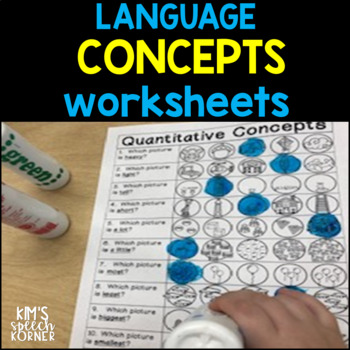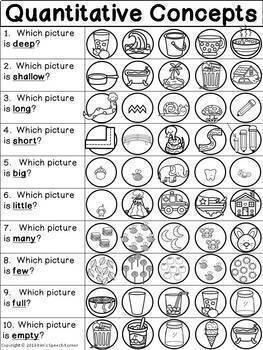Language Concepts | Speech Therapy Worksheets
Kim's Speech Korner
2.9k Followers
Grade Levels
K - 3rd
Resource Type
Standards
CCSSL.K.1e
CCSSL.K.5a
CCSSL.K.5b
CCSSL.1.1f
CCSSL.1.1i
Formats Included
- PDF
Pages
10 pages
Kim's Speech Korner
2.9k Followers
Also included in
- Are you looking for a fun, easy way to target speech and language concepts in speech therapy? If so, then this BUNDLED product is for you! This PRINT AND GO resource includes my Dot Artsy:Language Edition (17 pages of Categories, Associations, Negatives)WH Questions Edition (10 pages of WHO, WHAT, WPrice $9.99Original Price $11.49Save $1.50
Description
Are you looking for a fun, easy way to target speech and language concepts in speech therapy? If so, then this product is for you! This PRINT AND GO product includes:
- 3 pages of Spatial Concepts
- 1 page of Temporal Concepts
- 2 pages of Quantitative Concepts
- 3 pages of Qualitative Concepts
- 1 page of Emotional Concepts
Your students will enjoy using dot markers, colored pencils, or other art supplies as they work on their language goals and objectives.
You may also be interested in the Language Edition, which includes Categories, Associations, and Negatives. If so, you can find it by clicking here. Dot "Artsy"- Language-Categories/Associations/Negatives Worksheets
Or, you may be interested in the WH Questions Edition. If so, you can find it by clicking here. Dot Artsy with Pictures - WH Questions Edition - Activities/Worksheets
Total Pages
10 pages
Answer Key
Not Included
Teaching Duration
Lifelong tool
Last updated Feb 20th, 2019
Report this resource to TPT
Reported resources will be reviewed by our team. Report this resource to let us know if this resource violates TPT’s content guidelines.
Standards
to see state-specific standards (only available in the US).
CCSSL.K.1e
Use the most frequently occurring prepositions (e.g., to, from, in, out, on, off, for, of, by, with).
CCSSL.K.5a
Sort common objects into categories (e.g., shapes, foods) to gain a sense of the concepts the categories represent.
CCSSL.K.5b
Demonstrate understanding of frequently occurring verbs and adjectives by relating them to their opposites (antonyms).
CCSSL.1.1f
Use frequently occurring adjectives.
CCSSL.1.1i
Use frequently occurring prepositions (e.g., during, beyond, toward).






